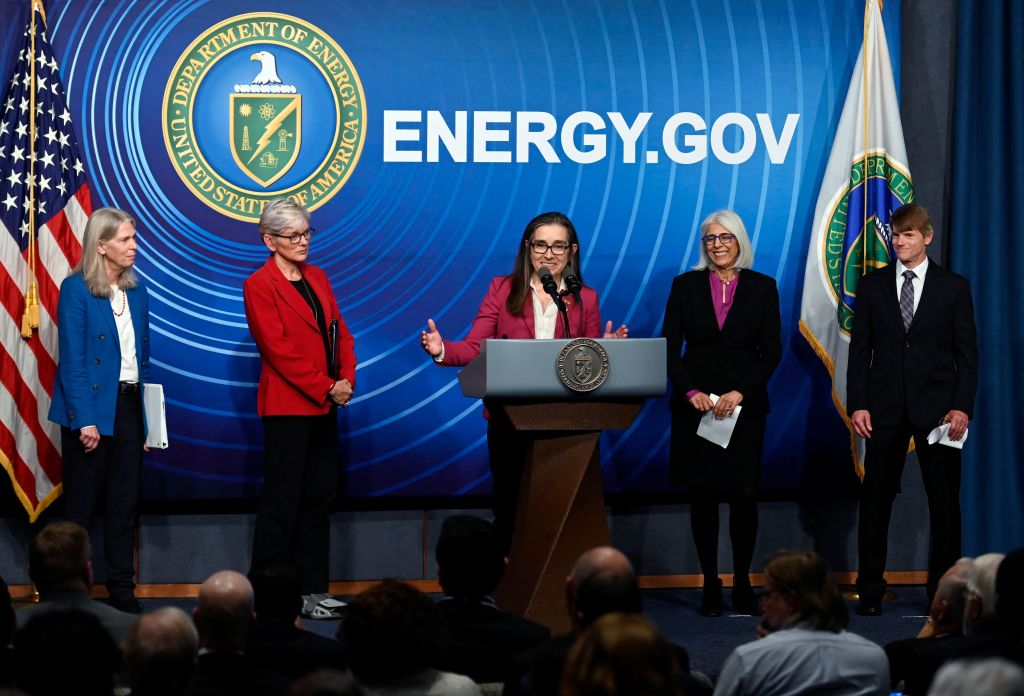What could be a step in the Energy Revolution that could change the way a far distant future society lives has taken place, according to new research that is being unveiled Tuesday.
The Department of Energy is announcing that for the first time, a laboratory experiment has been able to produce a fusion reaction in which the energy produced exceeded the energy needed to create the fusion reaction, according to The Washington Post.
While holding off the details pending Tuesday’s media announcement, the Department noted that Energy Secretary Jennifer Granholm will be announcing “a major scientific breakthrough.”
Proponents of fusion say it will revolutionize energy.
Can’t overstate the importance of this result!
“The fusion reaction at the US government facility produced about 2.5 megajoules of energy, which was about 120 per cent of the 2.1 megajoules of energy in the lasers…”#FusionEnergy #Lasers #Ignition #Breakeven @lasers_llnl https://t.co/VjsdOubKpl
— Fusion is the Future (@is_fusion) December 12, 2022
“Fusion is the Holy Grail of climate change and decarbonized future. Perhaps even more profoundly, fusion has the potential to lift more citizens of the world out of poverty than any idea since fire,” Democratic Rep. Don Beyer of Virginia said earlier this year, according to his website.
Unlike fission, which breaks apart the energy bonds of atoms, fusion smashes atoms together, releasing energy. Fusion research has been taking place since the 1950s, because unlike existing commercial forms of nuclear energy, there is no radioactive waste. Energy produced by the sun is an example of fusion.
Dr Arthur Turrell, a plasma physicist who wrote a book chronicling efforts to harness fusion, said the announcement is of vast importance, according to the Financial Times.
“If this is confirmed, we are witnessing a moment of history. Scientists have struggled to show that fusion can release more energy than is put in since the 1950s, and the researchers at Lawrence Livermore seem to have finally and absolutely smashed this decades-old goal,” he said.
Nuclear fusion has demonstrated a net energy gain. Researchers say nuclear power stations are still decades away, but “a small cup of the hydrogen fuel could theoretically power a house for hundreds of years.”
Here’s how it works: pic.twitter.com/zliy7HIgLs
— Jesse Wood (@jrhwood) December 12, 2022
The results of the work at the National Ignition Facility, though, are only a first step on a very long road.
“It’s about what it takes to boil 10 kettles of water. In order to turn that into a power station, we need to make a larger gain in energy — we need it to be substantially more,” said Jeremy Chittenden, co-director of the Centre for Inertial Fusion Studies at Imperial College in London, according to CNN.
So what’s next? After the research goes through a vetting process, the critical issue will be trying to scale up what was accomplished. In the lab, mammoth lasers were used in the process. In its reporting, the Post noted that “engineers have yet to develop machinery capable of affordably turning that reaction into electricity that can be practically deployed to the power grid.”
Machinery that could withstand the pounding process of fusion, using materials that are difficult to obtain and doing so on a broad scale, are major, daunting issues, leading proponents of fusion to stress that the breakthrough is not going to change the energy picture any time soon.
But it is a start, and also an advance in which the United States can say it achieved first.
“There is going to be great pride that this is something that happened in the United States. This is a very important milestone on the road toward fusion energy,” said David Edelman, who leads policy and global affairs at TAE, a large private fusion energy company.
The road forward is paved with American taxpayer dollars. As noted in the Financial Times, the so-called Inflation Reduction Act includes almost $370 billion for subsides that will back low-carbon energy research and development.
This article appeared originally on The Western Journal.

























 Continue with Google
Continue with Google